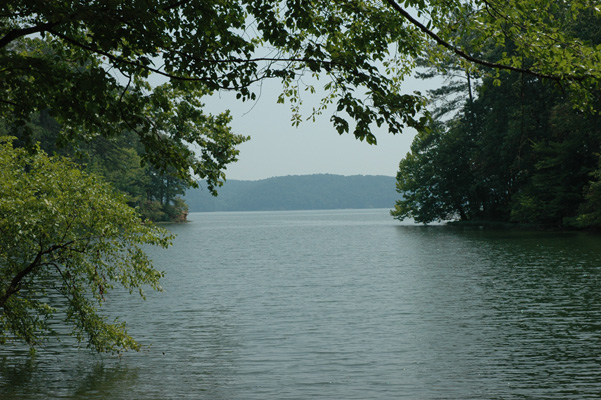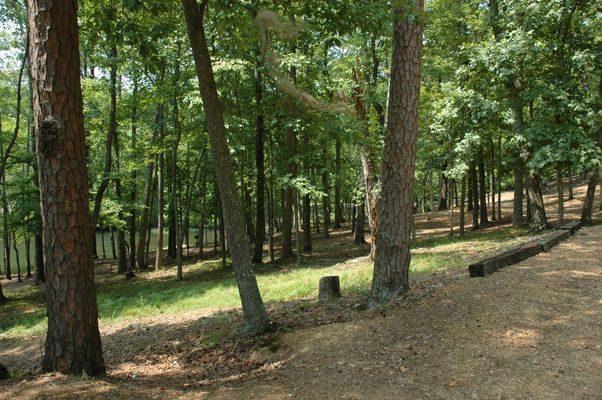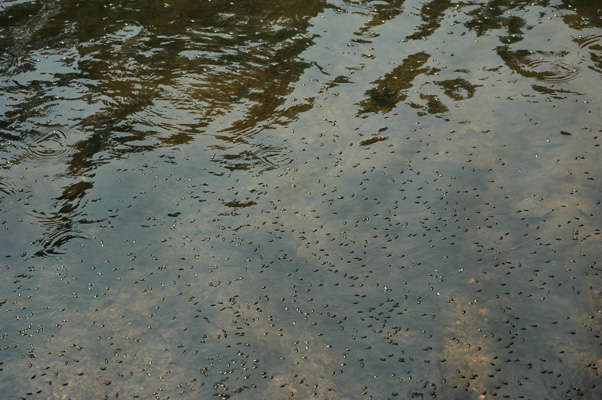Ants in J. P. Coleman State Park, Tishomingo County, Mississippi [MS State Park Ants]
Joe A. MacGown, JoVonn G. Hill, Rebekah J. Jones, and Stephanie Larrick
J. P. Coleman State Park is located just north of Iuka off Hwy 25 in Tishomingo County, in extreme northeast Mississippi. The park borders Pickwick Lake and part of the Tennessee River. For the most part, the park is centered around water sports. The park boast several amenities including cabins, camping sites, a marina and even a nice lodge. Unfortunately, there is really nothing in the way of hiking trails and wooded areas in general are limited to a strip bordering the river.

A view of Pickwick Lake
On 18 July 2006, we set off to collect ants at J. P. Coleman State Park and arrived there at about 10:30 A.M. It was a fairly typical day for this time of year in Mississippi as temperatures were over a 100° F in much of the state and it was even close to that this far north. Additionally, the state had been suffering from a serious lack of rain, and the soil in much of the state was very dry. We first went to the office to let them know we would be collecting ants in the park and grabbed a map of the park while we were there. After looking at the map, we realized that there really wasn't a nature trail to speak of, which would have been nice for our collecting, but not essential. We drove through the park to pick potential collecting spots. We settled on the primitive campground (34°55'33"N 88°10'22"W), which was an open deciduous forest (with a few pines near the parking area) on a slope that bordered a small arm of the lake. We also collected in the woods across the road from the campground, which was mostly hardwood in composition, but with some pines intermixed.

Primitive campground
Before getting started with our collecting, we put peanut butter on several of the larger oaks and pines surrounding the parking area in hopes of attracting some arboreal ants. No ants were collected at the peanut butter on the pines, but three species were collected on oaks including Monomorium minimum (Buckley) (the little black ant), Crematogaster ashmeadi Mayr (acrobat ant), and Temnothorax schaumii Roger. Although the little black ant and the acrobat ant are very common species that are easily collected by other methods, this is an ideal method for collecting the much slower, cryptic T. schaumii, which was once considered to be rare in the state, but is now found with regularity.
As we looked around the campground area, we found an abundance of the black carpenter ant, Camponotus pennsylvanicus (DeGeer) and a lesser number of the red and black Camponotus decipiens Emery. Small scattered colonies of imported fire ants, most likely the black one, Solenopsis richteri Forel, but possibly the hybrid form Solenopsis invicta x richteri, were also common at the site. A trail of Forelius mccooki (McCook) was seen going up and down a loblolly pine mere inches from a trail of fire ants. No interaction between the two species was seen. Monomorium minimum was another very common ant and was seen in large numbers nesting throughout the area. Paratrechina vividula (Nylander) and Aphaenogaster carolinensis (Wheeler) were found nesting in litter at bases of trees. One worker of a larger related species, Aphaenogaster treatae Forel, was collected as it crawled on the ground. Several species that we collected by hand were were also found in leaf litter as well as some other species including two ponerine species, Hypoponera opacior (Forel) and Ponera pennsylvanica Buckley, one dacetine species, Strumigenys louisianae Roger, and a formicoxenine ant, Temnothorax pergandei Emery. Vegetation at the edge of the lake was swept for ants, but no additional species were collected by this method.

Gyrinid beetles (whirl-a-gig beetles) whirling about at the edge of the lake
Ant collections were also made in the mixed woods across the road from the campground area. There were several downed trees in the area, which was situated on a steep slope. The black, bispinose Myrmecina americana Emery was found to be very common in the leaf litter. Similar to the more open area across the road, Camponotus pennsylvanicus, was seen crawling on the ground here. A colony of Paratrechina vividula was found in the soil in a gully full of leaf litter. A large colony of Aphaenogaster lamellidens Mayr was found in a rotting pine log and some representative workers were collected. This reddish-brown species can usually be recognized by its fairly large size (about the same size or slightly larger than a large fire ant), prominent propodeal spines, legs being mostly black, and the outer face of the frontal lobe bearing a flange which projects rearward in the form of a tooth (visible with magnification in frontal view). This is a very common woodland species that nests in rotting logs and standing dead trees, under bark of dead or live trees, and in dead sections of live trees. We have found this ant in both hardwoods and pines. A related species, Aphaenogaster carolinensis, was found nesting in soil and leaf litter. This common species is smaller than A. lamellidens, has shorter propodeal spines, is not as reddish in color, and has yellowish legs.
Two bags of leaf litter were collected in the woods across the road from the campground area. There were several downed trees in the area, which was situated on a steep slope. One bag of litter was sampled from a depression located about midway down the slope and the other sample was from a leaf litter filled gully that transected the slope. A few species not picked up by hand were found in these samples including Stigmatomma pallipes (Haldeman), Proceratium chickasaw de Andrade, Strumigenys rostrata Emery, Solenopsis sp. cf. molesta (Say), Pheidole dentigula Smith, and Temnothorax curvispinosus Mayr. There was only a couple of specimens of Stigmatomma (formerly in the genus Amblyopone) and only one of the Proceratium in the samples, but the other species were well represented by many individuals. As always when we find the minute S. sp. cf. molesta, there was a multitude of these little thief ants present. Strumigenys rostrata , which was very abundant in the two samples, appears to be our most common species in the genus in Mississippi. This species can usually be recognized in the field by its slightly larger size and its being faster than many of the other Strumigenys species in our area. Pheidole dentigula is another very common and abundant ant in Mississippi forests, as is T. curvispinosus, which were also both plentiful in the samples. This species of Pheidole typically nests in soil and leaf litter, whereas T. curvispinosus nests in soil and leaf litter as well as in hollow stems of many plants and in other hollow material such as acorns or hickory nuts.
At about 11:45 A.M. we decided to continue our collecting elsewhere, because the overall ant diversity appeared to be low. This could have been partially due to the drought-like conditions at the time of our collections, but also due to the fact that we only collected in one general area. However, this area offered good example of the habitats seen in the park and it seems likely that we that we collected many of the species indicative of this park. Overall, only twenty-three species of ants were collected and most of these were common species. The only species considered rare for Mississippi were Stigmatomma pallipes and Proceratium chickasaw. Stigmatomma pallipes is now known to occur in various localities throughout the state, but P. chickasaw has only been collected at two other localities in Mississippi.
On 26 May 2010, MacGown, Hill, and James Lewis collected in the park at the RV campground (34°55'16"N 88°10'21"W), the primitive campground (34°55'33"N 88°10'22"W), and the nature trail near the entrance (34°55'59"N 88°10'19"W). We collected a total of 34 species on this occasion, including 18 that we had not collected on the first trip. Those new records for the park included Camponotus americanus, C. nearcticus, C. subbarbatus, Crematogaster missuriensis, Discothyrea testacea, Formica pallidefulva, Nylanderia faisonesis, N. sp. (a yellow woodland species), Pheidole bicarinata, P. dentata, P. tysoni, Proceratium crassicorne, P. croceum, Strumigenys ohioensis, S. ornata, Temnothorax bradleyi, T. tuscaloosae, and Trachymyrmex septentrionalis.
Thus far, we have collected 41 species in the park, but we expect there to be quite a few present. In general, the park appeared to be relatively free of exotic ant species, with the exception of imported fire ants, which are common throughout the region.
List of ant species collected at J. P. Coleman State Park (arranged alphabetically by genus)
Aphaenogaster carolinensis (Wheeler)
Aphaenogaster lamellidens Mayr
Aphaenogaster treatae Forel
Camponotus americanus Mayr
Camponotus decipiens Emery
Camponotus nearcticus Emery
Camponotus pennsylvanicus (DeGeer)
Camponotus subbarbatus Emery
Crematogaster ashmeadi Mayr
Crematogaster lineolata (Say)
Crematogaster missuriensis Emery
Discothyrea testacea Roger
Forelius mccooki (McCook)
Formica pallidefulva Latreille
Hypoponera opacior (Forel)
Monomorium minimum (Buckley)
Myrmecina americana Emery
Nylanderia faisonensis (Forel)
Nylanderia vividula (Nylander)
Nylanderia sp.-02
Pheidole bicarinata Mayr
Pheidole dentata Mayr
Pheidole dentigula Smith
Pheidole tysoni Forel
Ponera pennsylvanica Buckley
Proceratium chickasaw de Andrade
Proceratium crassicorne Emery
Proceratium croceum (Roger)
Stigmatomma pallipes (Haldeman)
Strumigenys louisianae Roger
Strumigenys ohioensis Kennedy & Schramm
Strumigenys ornata Mayr
Strumigenys rostrata Emery
Solenopsis invicta x richteri
Solenopsis richteri Forel
Temnothorax bradleyi (Wheeler)
Temnothorax curvispinosus Mayr
Temnothorax pergandei Emery
Temnothorax schaumii Roger
Temnothorax tuscaloosae (Wilson)
Trachymyrmex septentrionalis (McCook)


